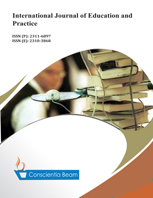Undergraduate students’ predilection for seating pattern and their engagement in a collaborated blended learning in the science education classroom
DOI:
https://doi.org/10.18488/61.v11i4.3508Abstract
The purpose of this study was to examine the influence of undergraduate students’ predilection of seating pattern on their engagement and achievement in a collaborated blended learning in a science education classroom. The sample of this study constituted 120 third year science education students. This research employed a mixed method design by using qualitative and quantitative studies. Two instruments named: Student’s performance and predilection for seating pattern (SPAPFSP) and Students’ class experience with the U-shape seating pattern (SCEUSP), choice of seating pattern and why the choice were used. The Cronbach alpha reliability for the instrument ranged from 0.89 to 0.91. Results of the analysis using a 2 by three analysis of variance indicated that the students in the U-shaped classroom achieved more than those in the row-column arrangement. A paired sample t-test analysis test results reported that students preferred the U-shape seating pattern in their classrooms. The implication of this study is that the seating pattern adopted by a teacher influences the educational outcome of students. It was therefore recommended among others that the U-shape seating arrangement be used in a blended science instruction.





